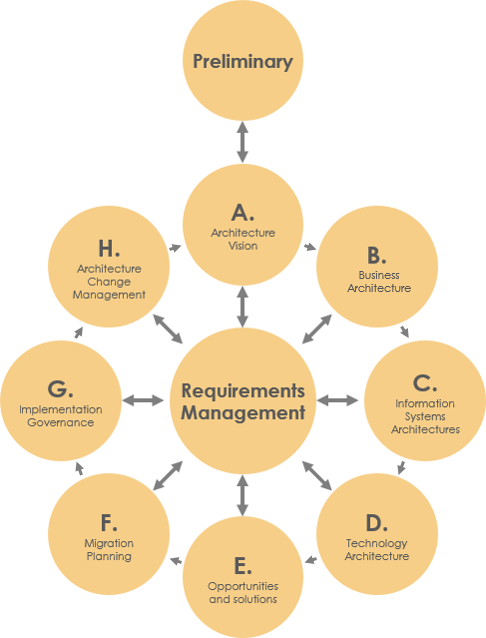Introduction
In the complex landscape of enterprise architecture, organizations require a structured and proven methodology to guide them through the process of developing robust and effective architectures. The Architecture Development Method (ADM) stands as the linchpin of The Open Group Architecture Framework (TOGAF), offering a meticulously crafted and repeatable process for architecture development. This article delves into the components and phases of the ADM, shedding light on its integral role in shaping successful enterprise architectures.
The Phases of ADM

- Preliminary:
The journey begins with the Preliminary phase, where the organization prepares itself for the architectural endeavor. This involves establishing the groundwork, understanding the organizational context, and ensuring that key stakeholders are aligned and committed to the architectural process.
- Architecture Vision:
Setting the stage for the entire architectural development, the Architecture Vision phase defines the scope, constraints, and expectations of the architecture. It serves as a guiding beacon, aligning the architectural efforts with the strategic goals of the organization.
- Business Architecture:
In this phase, the focus shifts to developing baseline and target architectures for Business Architecture. Understanding the business processes, capabilities, and organizational structure is crucial for creating a foundation that aligns with business objectives and sets the stage for subsequent architectural development.
- Information Systems Architecture:
The Information Systems Architecture phase delves into developing baseline and target architectures for information systems. This involves a comprehensive analysis of data architecture, application architecture, and technology architecture to ensure coherence and alignment with business needs.
- Technology Architecture:
Technology Architecture is dedicated to developing baseline and target architectures for the technological infrastructure. It addresses the hardware, software, and network components, ensuring that the technology landscape is not only aligned with business and information architectures but also future-proofed for scalability and adaptability.
- Opportunities and Solutions:
The Opportunities and Solutions phase marks the transition to implementation planning. It involves identifying and evaluating potential initiatives and projects, aligning them with the established architectures, and laying the groundwork for effective execution.
- Migration Planning:
This phase involves a meticulous analysis of costs, benefits, and risks associated with the proposed changes. Migration Planning ensures that the architectural changes are not only strategically sound but also financially viable, minimizing risks and maximizing the return on investment.
- Implementation Governance:
Providing architectural oversight to the implementation process, Implementation Governance ensures that the actual execution aligns with the envisioned architectures. This phase serves as a crucial checkpoint, mitigating deviations and ensuring the fidelity of the implemented solution.
- Architecture Change Management:
Change is inevitable, and the Architecture Change Management phase addresses this reality by providing continual monitoring and a structured change management process. It ensures that the architecture remains dynamic and responsive to evolving business needs.
- Requirements Management:
Validating and enforcing business requirements is the final phase of the ADM. It ensures that the developed architectures not only align with the initial specifications but also meet the evolving needs of the organization.
Conclusion
TOGAF’s Architecture Development Method (ADM) is a comprehensive and systematic approach that empowers organizations to navigate the intricate journey of architecture development. By traversing through its well-defined phases, organizations can create architectures that are not only aligned with strategic objectives but also agile and responsive to change. As a tested and repeatable process, ADM stands as a beacon for organizations seeking excellence in enterprise architecture, providing the guidance needed to transform visions into tangible and successful realities.
